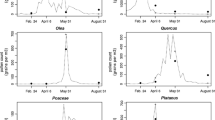Abstract
The importance of the transport of pollen by air movement into houses was evaluated using six to eight simultaneously collecting rotorod-type samplers, creating either a sampler line from outdoors to inside the room, or a sampler grid inside a room. The number of incoming pollen grains was highly dependent on the outdoor concentration. The highest concentrations inside (1–2 m distance) and outside (1 m) the room were 600 and 3,250 grains/m3, respectively, in the Betula pollen season and 1,980 and 5,080 grains/m3 in the Pinus season. The pollen concentration and the indoor/outdoor (I/O) ratio decreased as the distance from the ventilation opening increased. Inside the room at a distance of 1–2 m 28%, and at a distance of 3–5 m 12%, of the outside concentration was recorded. In the lower part of the opening the mean proportion was 63% and in the upper part of the opening it was 40%. Efficient ventilation with two open windows increased the I/O ratio and enabled the pollen to spread throughout the room. During the Pinus pollen season 3–35% of the outdoor concentration was simultaneously recorded at six locations inside the room with two open windows and only 0.1–3.6% with one open window. At the same point in the room the I/O ratio varied from <1 to 35%, depending on the sampling conditions. Only a minor effect on the I/O ratio was found between small and large ventilation windows and the door, although it was expected that more air and pollen grains would come indoors through a larger opening.





Similar content being viewed by others
References
Cariñanos, P., Alcázar, P., Galán, C., Navarro, R., & Dominquez, E. (2004). Aerobiology as a tool to help in episodes of occupational allergy in work places. Journal of Investigational Allergology and Clinical Immunology, 14, 300–308.
Clot, B. (2001). Airborne birch pollen in Neuchatel (Switzerland): Onset, peak and daily patterns. Aerobiologia, 17, 25–29. doi:10.1023/A:1007652220568.
D’Amato, G., Liccardi, G., Saggese, M., Mistrello, G., D’Amato, M., & Falagiani, P. (1996). Comparison between outdoor and indoor airborne allergenic activity. Annals of Allergy, Asthma & Immunology, 77, 147–152.
Enomoto, T., Onishi, S., Sogo, H., Dake, Y., Ikeda, H., Funakoshi, H., et al. (2004). Japanese cedar pollen in floating indoor house dust after pollinating season. Allergology International, 53, 279–285. doi:10.1111/j.1440-1592.2004.00345.x.
Ertdman, G. (1969). Handbook of palynology. Morphology, taxonomy and ecology. Copenhagen: Munksgaard.
Fahlbusch, B., Hornung, D., Heinrich, J., & Jäger, L. (2001). Predictors of group 5 grass-pollen allergens in settled house dust: Comparison between pollination and nonpollination seasons. Allergy, 56, 1081–1086. doi:10.1034/j.1398-9995.2001.00106.x.
Hirst, J. M. (1952). An automatic volumetric spore trap. The Annals of Applied Biology, 39, 257–265. doi:10.1111/j.1744-7348.1952.tb00904.x.
Hugg, T., & Rantio-Lehtimäki, A. (2007). Indoor and outdoor pollen concentrations in private and public spaces during the Betula pollen season. Aerobiologia, 23, 119–129. doi:10.1007/s10453-007-9057-z.
Ishibashi, Y., Ohno, H., Oh-ishi, S., Matsuoka, T., Kizaki, T., & Yoshizumi, K. (2008). Characterization of pollen dispersion in the neighborhood of Tokyo, Japan in spring of 2005 and 2006. International Journal of Environmental Research and Public Health, 5, 76–85. doi:10.3390/ijerph5020076.
Kiyosawa, H., & Yoshizawa, S. (2001). Study of the control of indoor pollen exposure. Part 1. Intrusion of airborne pollen into indoor environment and exposure dose. Journal of Architecture, Planning and Environmental Engineering, 548, 63–68 (in Japanense, abstract in English).
Lee, T., Grinshpun, S. A., Martuzevicius, D., Adhikari, A., Crawford, C. M., Luo, J., et al. (2006). Relationship between indoor and outdoor bioaerosols collected with a button inhalable aerosol sampler in urban homes. Indoor Air, 16, 34–47. doi:10.1111/j.1600-0668.2005.00396.x.
O’Rourke, M. K., & Lebowitz, M. D. (1984). A comparison of regional atmospheric pollen with pollen collected at and near homes. Grana, 23, 55–64.
Rantio-Lehtimäki, A., Helander, M. L., & Pessi, A. -M. (1991). Circadian periodicity of airborne pollen and spores; significance of sampling height. Aerobiologia, 7, 129–135. doi:10.1007/BF02270681.
Richmond-Bryant, J., Eisner, A. D., Brixey, L. A., & Wiener, R. W. (2006). Transport of airborne particle within a room. Indoor Air, 16, 48–55. doi:10.1111/j.1600-0668.2005.00398.x.
Schwendemann, A. B., Wang, G., Mertz, M. L., McWilliams, R. T., Thatcher, S. L., & Osborn, J. M. (2007). Aerodynamics of saccate pollen and its implications for wind pollination. American Journal of Botany, 94, 1371–1381. doi:10.3732/ajb.94.8.1371.
Spiegelman, J., Friedman, H., & Blumstein, G. I. (1963). The effects of central air conditioning on pollen, mold, and bacterial concentrations. The Journal of Allergy and Clinical Immunology, 34, 426–431.
Sterling, D. A., & Lewis, R. D. (1998). Pollen and fungal spores indoor and outdoor of mobile homes. Annals of Allergy, Asthma & Immunology, 80, 279–285.
Stock, T. H., & Morandi, M. T. (1988). A characterization of indoor and outdoor microenvironmental concentrations of pollen and spores in two Houston neighbourhoods. Environment International, 14, 1–9. doi:10.1016/0160-4120(88)90370-4.
Takahashi, Y., Takano, K., Suzuki, M., Nagai, S., Yokosuka, M., Takeshita, T., et al. (2008). Two routes for pollen entering indoors: Ventilation and clothes. Journal of Investigational Allergology and Clinical Immunology, 18, 382–388.
Viander, M., & Koivikko, A. (1978). The seasonal symptoms of hyposensitized and untreated hay fever patients in relation to birch pollen counts: Correlation with nasal sensitivity, prick tests and RAST. Clinical Allergy, 8, 387–396. doi:10.1111/j.1365-2222.1978.tb00474.x.
Vural, C., & Ince, A. (2008). Pollen grains in the house dust of Kayseri, Turkey. International Journal of Natural and Engineering Sciences, 2, 41–44.
Yankova, R. (1991). Outdoor and indoor pollen grains in Sofia. Grana, 30, 171–176.
Acknowledgments
The study was financially supported by the South Karelia Regional Fund of the Finnish Cultural Foundation. We thank Auli Rantio-Lehtimäki for her valuable comments on the manuscript.
Author information
Authors and Affiliations
Corresponding author
Rights and permissions
About this article
Cite this article
Jantunen, J., Saarinen, K. Intrusion of airborne pollen through open windows and doors. Aerobiologia 25, 193–201 (2009). https://doi.org/10.1007/s10453-009-9124-8
Received:
Accepted:
Published:
Issue Date:
DOI: https://doi.org/10.1007/s10453-009-9124-8




